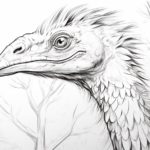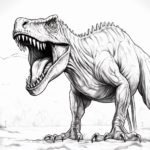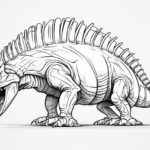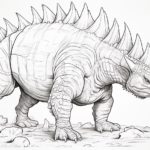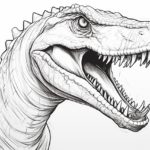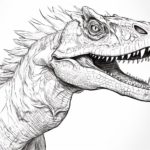Welcome to the world of drawing, where we can bring to life the magnificent Argentinosaurus with just a pencil and paper! Argentinosaurus is one of the largest dinosaurs to have ever roamed the Earth, making it a fascinating subject for artists of all ages. Its massive size and unique features present an exciting challenge for artists looking to capture the grandeur of this giant herbivore on paper. In this tutorial, we will explore the key characteristics of the Argentinosaurus and provide step-by-step guidance on how to draw this awe-inspiring creature with accuracy and detail. So grab your drawing supplies and let’s embark on a prehistoric journey as we learn to sketch the mighty Argentinosaurus!
Materials Required
To draw an Argentinosaurus, a large dinosaur species, you will need the following materials:
- Drawing paper or sketchbook
- Pencils (preferably a range of graphite pencils for shading)
- Eraser (both kneaded and white eraser for precision erasing)
- Fine-tipped black pen or marker (optional for outlining)
- Reference images of an Argentinosaurus for accuracy
- Colored pencils or markers (optional for adding color)
- Ruler or straight edge (optional for creating straight lines)
These materials will help you create a detailed and accurate drawing of an Argentinosaurus.
How to Draw an Argentinosaurus: a Step-by-step Guide
Step 1: Research and Reference
Before starting to draw an Argentinosaurus, it’s essential to research and gather reference images of this dinosaur. Study its anatomy, proportions, and distinctive features to ensure accuracy in your drawing.
Step 2: Sketching the Basic Shapes
- Begin by lightly sketching the basic shapes to establish the overall structure of the Argentinosaurus. Start with an oval for the body and a smaller oval for the head.
- Add a long, curved line from the head to represent the neck. Connect the body oval with a larger oval for the hip area.
- Draw simple lines for the legs and tail to define their placement and proportions.
Step 3: Refining the Body Structure
- Refine the body by adding more details to the basic shapes. Define the chest area by adding a slightly curved line below the neck.
- Add more definition to the legs by sketching the basic shapes for the upper and lower parts of each leg.
- Extend the tail by drawing a long, curved line that tapers towards the end to create the tail’s shape.
Step 4: Adding Details and Features
- Focus on detailing the head by adding the eyes, nostrils, and mouth. Pay attention to the shape of the head and the placement of these features.
- Add details to the body, such as scales or skin texture, to give your Argentinosaurus a more realistic appearance.
- Define the legs by adding muscle definition and joint details. Study reference images to accurately depict the dinosaur’s powerful limbs.
- Include the distinctive long neck of the Argentinosaurus by adding appropriate folds and creases to indicate its flexibility and size.
Step 5: Finalizing and Refining
- Once you are satisfied with the overall structure and details, go over your sketch with darker lines to define the final drawing.
- Erase any unnecessary guidelines and construction lines to clean up the drawing and make it appear more polished.
- Add shading and highlights to give your Argentinosaurus drawing depth and dimension. Consider the light source to determine where shadows fall.
- Take your time to refine any areas that need more attention, such as adding more texture to the skin or adjusting proportions for accuracy.
Step 6: Practice and Patience
Drawing a complex subject like the Argentinosaurus may require practice and patience. Don’t be discouraged if your first attempt doesn’t turn out as expected. Keep practicing and refining your skills to improve your dinosaur drawings over time.
Conclusion
In conclusion, mastering the art of drawing an Argentinosaurus requires attention to detail, practice, and patience. By following the step-by-step guide outlined in this article and honing your skills through consistent practice, you can bring this magnificent creature to life on paper. Remember to stay true to the proportions and characteristics of the Argentinosaurus, while also infusing your own creativity and style into your artwork. With dedication and perseverance, you can create stunning and lifelike representations of this iconic dinosaur. Keep practicing, exploring new techniques, and pushing your artistic boundaries to continue improving your drawing skills and capturing the majestic essence of the Argentinosaurus.
Fun Facts About Argentinosauruses
- Argentinosaurus is one of the largest dinosaurs ever discovered, with estimated lengths of up to 100 feet and weights of up to 100 tons.
- Despite its massive size, Argentinosaurus was a herbivore, feeding on plants and vegetation to sustain its enormous body.
- Fossils of Argentinosaurus have been found in Argentina, specifically in the Patagonia region, hence its name which means “Argentine lizard.”
- It is believed that Argentinosaurus lived during the Late Cretaceous period, around 94-97 million years ago.
- The long neck of Argentinosaurus allowed it to reach high into trees to feed, similar to modern-day giraffes.
- Scientists believe that Argentinosaurus may have traveled in herds for protection and to find enough food to sustain their large bodies.
- Despite its massive size, Argentinosaurus had a relatively small brain compared to its body size, indicating that it may not have been the most intelligent dinosaur.
- The discovery of Argentinosaurus fossils has provided valuable insights into the size and behavior of giant sauropods that roamed the Earth millions of years ago.
- Some estimates suggest that Argentinosaurus could have had a heart weighing as much as a small car to pump blood to its massive body.
- The study of Argentinosaurus and other sauropods continues to fascinate scientists and dinosaur enthusiasts, helping us better understand the diversity and adaptations of prehistoric creatures.
Suggestions for Scenes and Settings for Argentinosaurus Drawings
Of course! Here are some specific suggestions for scenes and settings to draw Argentinosaurus in:
- Jurassic Landscape: Place Argentinosaurus in its natural habitat during the Jurassic period. Draw lush greenery, ferns, and giant trees towering above the massive dinosaur.
- Riverbank: Show Argentinosaurus peacefully grazing near a riverbank, with its reflection in the water. Add details like fish swimming in the river and birds flying overhead.
- Volcano Eruption: Create a dramatic scene with Argentinosaurus in the foreground and a volcano erupting in the background. Show ash clouds, lava flows, and a dark, ominous sky.
- Mountain Range: Draw Argentinosaurus wandering through a mountainous landscape. Include rugged peaks, rocky terrain, and a clear blue sky with fluffy clouds.
- Sunset Silhouette: Capture the silhouette of Argentinosaurus against a vibrant sunset sky. Add warm hues of orange, pink, and purple to create a stunning and atmospheric scene.
- Swampy Marsh: Depict Argentinosaurus in a swampy marshland, surrounded by murky water, tall grasses, and prehistoric creatures like pterosaurs and small dinosaurs.
- Coastal Cliffs: Show Argentinosaurus near coastal cliffs overlooking the ocean. Include crashing waves, seagulls flying overhead, and a distant horizon dotted with islands.
- Dense Forest: Place Argentinosaurus in a dense prehistoric forest, with towering trees and lush vegetation all around. Add small details like ferns, mushrooms, and insects.
- Desert Oasis: Draw Argentinosaurus seeking shade near a desert oasis. Include palm trees, a shimmering pool of water, and other desert plants like cacti and succulents.
- Meteor Shower: Create a scene with Argentinosaurus witnessing a meteor shower in the night sky. Add shooting stars, brightly lit meteors, and a sense of wonder and awe.
Feel free to mix and match these suggestions or come up with your own unique ideas to bring Argentinosaurus to life in various captivating scenes and settings!




